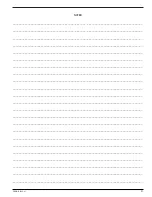
L4463
(
rev
.
c
)
11
6.7 Air Lubricator - Oil Drip Rate Adjustment
The air lubricator drip rate must be adjusted before torque
wrench is used on nut or bolt. See Figure 6.
To make an initial adjustment:
1. Be sure that the torque wrench is NOT mounted on a
nut or bolt.
2. Turn on the compressed air supply.
3. Press and release the green ON/ADV button on the
pendant to start the pump.
4.
While the pump is running, adjust the user-adjustable
relief valve so that the hydraulic pressure gauge
indicates zero (0) psi/bar.
5. As the pump continues running, look for oil drops
inside the lubricator sight dome (located just below
the drip rate adjustment screw).
6. Set the oil drip rate to one or two drops per minute
while the pump is running. Using a small flat blade
screwdriver, turn the adjustment screw counter-
clockwise to increase the drip rate and clockwise to
decrease it.
7. Re-check the oil drip rate after the system has been
in use and reaches its normal operating temperature.
Readjust the drip rate if needed.
Refer to air lubricator manufacturer’s instructions for
additional information.
NOTICE
To check for proper air lubrication levels, hold a
mirror near the pump air muffler exhaust outlet. If a heavy
oil film develops, reduce the drip rate as required.
7.0 LIFTING AND TRANSPORTING
• Always disconnect both hydraulic hoses and the air
supply hose before lifting or transporting the pump.
CAUTION
Never lift the pump with the hoses connected.
The lifting eye is to be used for lifting the pump only. It
is not designed to support the additional weight of the
hoses and torque wrench. If overloading occurs, eyebolt
and related components could fail, allowing pump to drop
suddenly. Minor or moderate personal injury and property
damage could result.
• Use appropriately rated lifting equipment that will
fully support the pump’s total weight including the
oil in the reservoir. Refer to Section 3.1 for weights.
• Lift the pump using only the built-in lifting eye. See
Figure 7 for location. DO NOT use the roll cage, hydraulic
reservoir or air motor housing as a lifting point.
• Before lifting, check that pump lifting eye, lifting eye
support bracket and associated mounting hardware
are tightly installed and in good condition.
CAUTION
If bracket, lifting eye or fasteners show
signs of wear, rust or deformation, replace these parts
before lifting or transporting the pump. Tighten any loose
fasteners. if lifting eye is replaced, be certain that the
replacement M12 lifting eye is rated for pump weight and
is DIN580/582 compliant.
• Do not allow personnel to place their body
(hands, feet. etc.) under the pump while it is being
transported, lifted or lowered.
Figure 7: Pump Lifting Eye
8.0 OPERATION
8.1 Pre Start-up Checklist
• Check all hydraulic system fittings and connections
to be sure they are tight and leak free.
• Check oil level in hydraulic reservoir. Refer to
Section 6.2 for instructions.
• Be certain that compressed air supply hose is
connected to the pump and that compressed air
system is turned on. Verify that air pressure and flow
are sufficient to operate the torque wrench being
used, as described in Section 6.4 of this manual.
• Check that the air lubricator is filled with air lubricant
oil and that the oil drip rate is 1-2 drops per minute
while the pump is running. Refer to Sections 6.6
and 6.7 of this manual.
• Before placing the torque wrench on a nut or bolt,
remove air from hydraulic lines and components as
described in Section 8.4. Then, set the maximum
pressure required for your bolting application and
the torque wrench being used. Refer to instructions
in Section 8.5.
NOTICE
Perform air removal and pressure (torque)
adjustment at initial start-up and whenever a different
torque wrench is connected to the pump.
• Refer to the torque wrench manufacturer’s
instructions for important safety, operation and
maintenance instructions applicable to the wrench
being used with the pump.










































